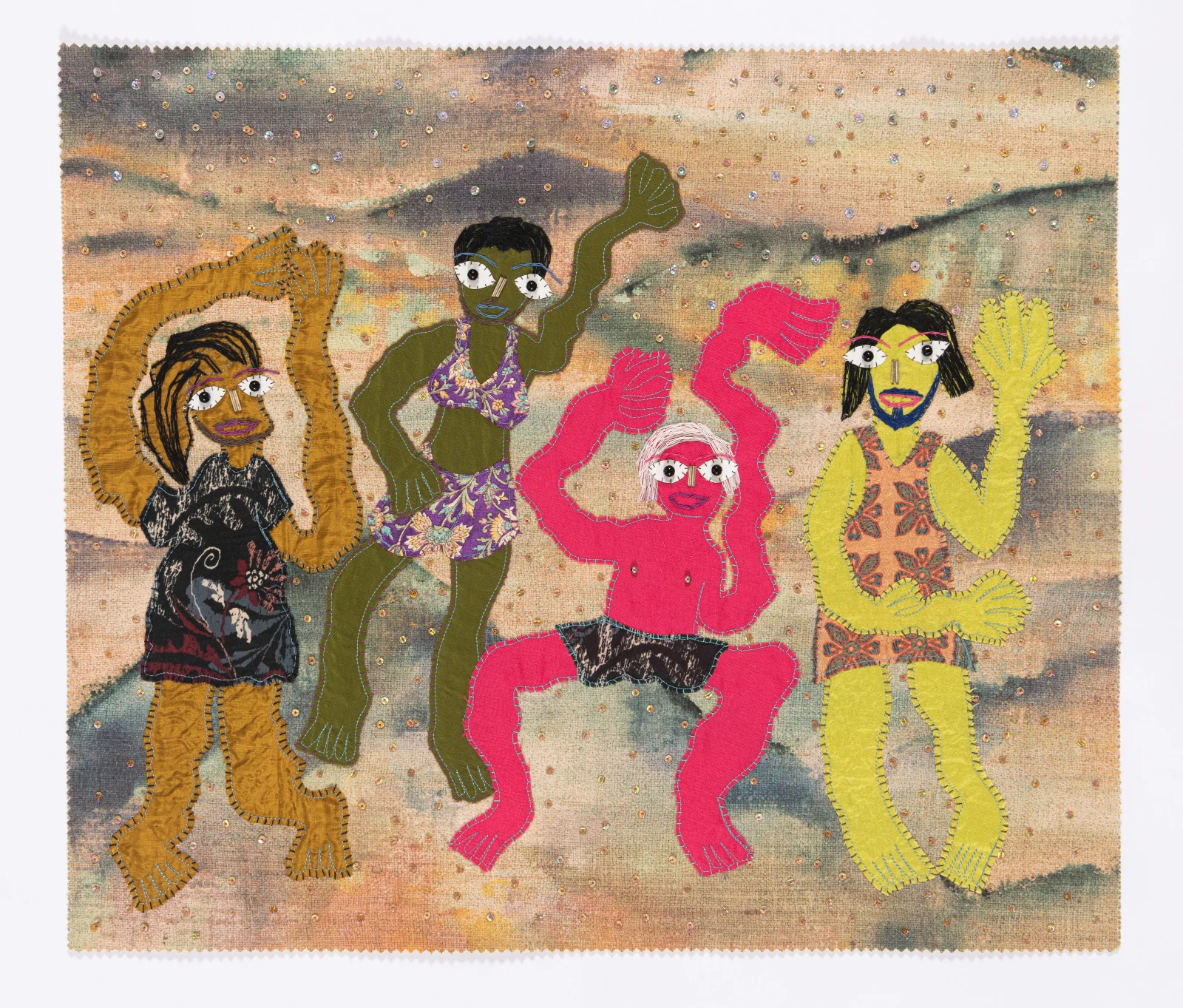Maurizio Cattelan’s Comedian which was a banana duct-taped to a wall recently sold at Art Basel Miami Beach for $120,000. The exorbitant price tag for a seemingly absurd piece of art brought up the question, “What is art?” “What is considered art and what is not?” “Can anything be art?”
This debate and discussion is what Cattelan set out to achieve with this piece of art. What seems like a relatively recent and Millenial idea, has actually been around for centuries. The innate sense of rebellion instilled in artists has resulted in the ever-evolving nature of art, challenging social norms and acceptability. But there is a moment in art history which can be traced back to as the origin of this question looming over our heads.
On April 9th, 1917, the Society of Independent Artists held their inaugural exhibition at The Grand Central Palace in New York. Wanting to submit an artwork to the Society which claimed that it would accept all artworks as long as the artist paid the application fee, Duchamp presented an upside-down urinal signed and dated with the appellation “R. Mutt, 1917,” and titled Fountain.
Before we try and answer this question, it might actually help us to answer who art is for. The acceptability and definition of art depend on its viewers and pre-existing social norms. For example, back in the 1860s when Claude Monet and the impressionists began painting intangible concepts such as movement and light, they were widely discredited by critics for not keeping with the social norms of art mirroring reality. While the minuscule and highly selective “art world” might have a certain opinion about these concepts, we believe questions like these require the opinions of the greater public. Art Fervour is determined to make art accessible to all, inviting the greater public to answer these questions. Which is why we bring to you a Museum of artworks ranging from highly conceptual and creative, to utterly bizarre.
In Art Fervour’s (street) Museum, we ask the viewers to tell us, “Do these artworks belong in the sanctity of a museum?”, “Who is art really for?” and of course, “What is art?”.
Marcel Duchamp, ‘The Fountain’, 1917.

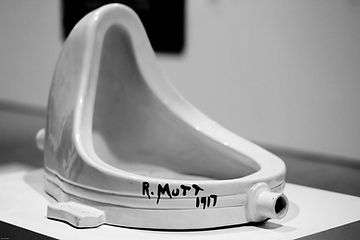
Marcel Duchamp was a French-American painter, sculptor, chess player and writer whose work is associated with the anti-rational, anti-art and proto-Dada cultural movement in New York City. ‘Fountain’ is a readymade sculpture produced in 1917 of a porcelain urinal signed “R.Mutt.” Duchamp pioneered the art movement that placed “readymades” in the forefront of exhibited art. As defined in Andre Breton and Paul Eluard’s Dictionnaire abrégé du Surréalisme as “an ordinary object elevated to the dignity of a work of art by the mere choice of an artist.” In the spring of 1917, The Society of Independent Artists prepared for an exhibition allowing any artist to present their works if they agreed to pay a nominal participatory fee, of which Duchamp was a founding member. The organisation’s avante-garde ideology included it’s commitment to never reject work submitted by any of its members. Duchamp submitted the urinal only to see that his work was never placed in the show and instead was covered to obscurity. By simply choosing the object of the urinal and repositioning or joining titling and signing it the Found object became art. Duchamp was not interested in what he called “retinal art” or art that was only visual and instead sought other methods of expression. ‘The Fountain’, 1917 is regarded by art historians of the avant- garde as a major landmark in 20th century art and paved the way for a new school of artists and critics alike to hone a new way of looking at objects establishing different ideas of Modern Art.
Kazimir Malevich, ‘White On White’, 1918.

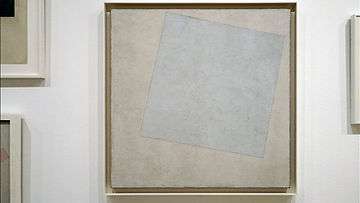
“I have overcome the lining of the colored sky. . . . Swim in the white free abyss, infinity is before you.” – Kazimir Malevich.
Kazimir Severinovich Malevich was a Russian avant-garde artist, art theorist, and pioneer of a non-objective art style popularly known as “Suprematism”. Malevich believed that art should be an activity that justifies itself of spiritual aspiration rather than dealing with the conventional ideas of practicality. He went on to influence larger genres such as fashion and architecture that follows his ideals of abstract shapes and forms to evoke emotional responses commonly felt in Abstract Art. ‘White On White’ was created in 1918, during the Russian Revolution. The inspiration behind this painting emerged from a sense of liberation that was being cast in Russia, sending ripples
WHAT IS ART?around the world. The ingenuity of this piece was derived from his fascination with technology, particularly the airplane. ‘White on White’ is meant to create a sense of levitation and transcendence. White, Malevich believed was the colour of infinity and signified a realm of higher feeling, a utopian world of pure form obtainable only through non-objective art that remained the premise of Suprematism. The painting depicts an off white square position at a slight angle, placed on a white background that appears to be warmer and denser in colour. Although the smaller white square appears to be stuck onto another white square, both squares actually lie on the same plane and have been painted on a single canvas.
Piero Manzoni, ‘Artists Shit’, 1961.
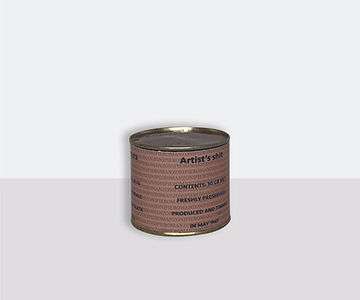
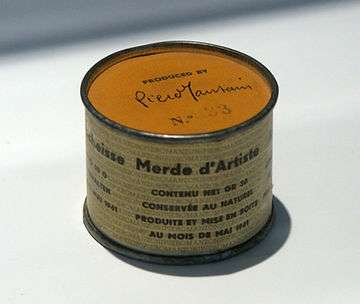
Piero Manzoni’s art is best synonymous with the ideologies of Karl Marx’s idea of commodity fetishism that compares the relationships we impose on commodities exchanged in the market as similar to the social relationships that we form throughout our lives. There have been parallels that many art critics have made citing Marcel Duchamp and his readymades that explores the concept of found objects recognised as art. Under these ideological lenses “Artist’s Shit” is said to be “an act of defiant mockery of the art world, artists, and art criticisms.” Manzoni has explored the relationship between art production and human production with ‘Artist’s Breathe (Fiato d’artista), a series of balloons filled with his own breath. There have been many explanations for the creation of ‘Artist’s Shit’ one of them tracing back to his own relationship with his father, who owned a canner. He is said to have once told his artist son :“Your work is shit.” For Manzoni, the most intimate thing for an art collector, most personal manifestation of an artist, would really be his own faeces. The work “Artists Shit” consists of 90 tin cans, each filled with 30 grams of faeces with a label in Italian, French, German, and English. The tins were originally valued according to their equivalent weight in gold, $37 each in 1961, with the price fluctuations according to the market.
Barbara Kruger, ‘I Shop Therefore I Am’, 1987.
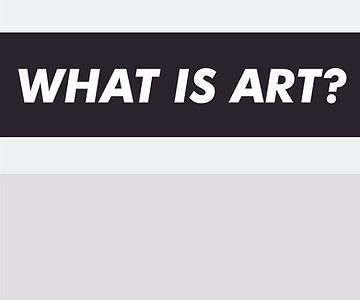
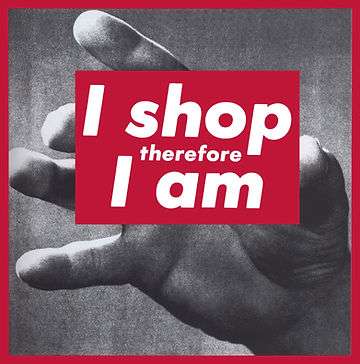
Most people would believe that the most popular typeface in the world right now can be credited to streetwear brand, Supreme and Instagram to a lesser extent. But this signature typeface was actually created by Barbara Kruger before being ripped off by Supreme. Barbara Kruger uses her artistic practice to critique capitalism and consumer culture. Her satirical work is best known for their direct, aggressive and hard-hitting slogans coupled with found images in the backdrop. As a growing artist in the male-dominated 60s and 70s, Kruger drew inspiration from second-wave feminism. Her signature style is influenced by her early work as a graphic designer for various magazines, photomontages, Russian Constructivism, Conceptual art and poetry. ‘I Shop Therefore I Am’ created in 1987, references Descartes’ famous declaration “I think therefore I am” while tweaking it to comment on ever-growing consumerism.
In our street Museum, we asked you “WHAT IS ART?” in Barbara Kruger’s signature font, and not Supreme.
Felix Gonzalez Torres, ‘Untitled (Portrait of Ross in L.A)’, 1991.
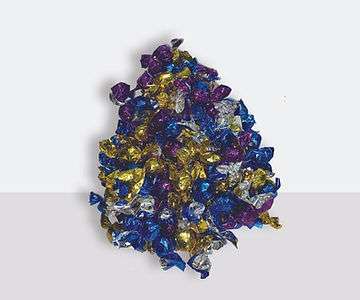
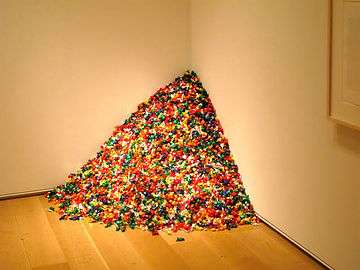
Felix Gonzalez Torres is known as an American conceptual, post-minimal and relational aesthetic artist. In this particular artwork, one that he is most commonly recognised for is titled ‘Untitled (Portrait of Ross in L.A)’. Created in 1991, this artwork is a 175 pound pile of candy, the weight that corresponds to his partner Ross’s (healthy) weight before he contracted HIV (aids) hence the name ‘Portrait of Ross.’
Visitors were implored to take the candy wrapped in colorful cellophane paper. As the visitors continued to pick up the candy, the pile kept diminishing, symbolic of how the viruses ate away at the health of Ross, who passed away in 1991. When the pile would finally be depleted, it would be replenished signifying the cycle of life and death.
This candy-picking playful installation probes into a much deeper and ignored reality that HIV patients are confronted with. By encouraging people to take candy, the viewers are participating in a complex narrative that hopes to bring to the surface the stigma that the disease is linked to and the failure of support, research or treatment that led to thousands of early deaths.
Cody Choi, ‘Thinkers’, 1996.
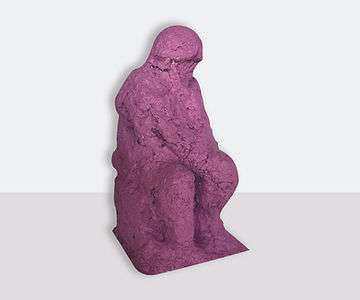
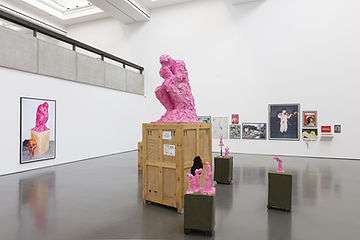
Cody Choi is known for his decisive role in the international art scene and is popular for his appropriated artworks. In the artwork titled ‘Thinkers’ shown in 1996 at the Jeffrey Deitch gallery, Choi appropriates the famous sculpture of the ‘Thinker’ by Auguste Rodin created in the 19th century. The artwork is created solely out of toilet paper and Pepto-Bismol, an American over-the-counter antacid. Choi is known to adapt Western works of art and has previously used the same approach with master-artists such as Michelangelo, Marcel Duchamp, Gerhard Richter and as seen above, Auguste Rodin. The two objects used in the artworks are symbolic of the cultural shock he received on first moving to America to pursue a career in art. The “cultural indigestion” that he experienced stemmed from frequent pain from stomach and bowel problems. Unable to afford a clinic visit, he would often use Pepto-Bismol as a form of relief.
This artwork reflects what it means to be “an Asian” in the United States, and now for Choi as “an American” back in his ancestral homeland. Cultural commentary is the bedrock of Cody Choi’s artistic practice.
Olafur Eliasson, ‘Ice Watch’, 2015.
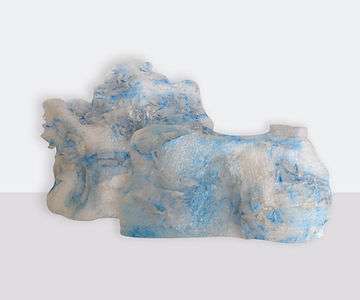
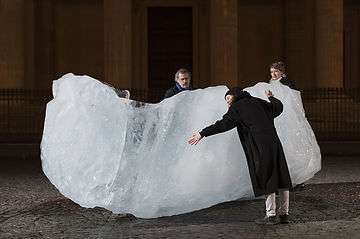
Olafur Eliasson is known for his sculptures and large scale installation art that employs his signature materials such as light, water, and air temperature to enhance the viewer’s experience. Eliasson’s installations majorly depend on the viewer’s reception and experience inside the public spaces that he works in. In 2019, he was appointed as the United Nations Development Programme’s newest Goodwill Ambassador for climate action and Sustainable Development Goals for his efforts to advance sustainable development with his projects, namely ‘Little Sun’ a project that provides solar energy through a solar-powered lamp in the shape of a sunflower. In ‘iceberg sIce Watch’ the Icelandic-Danish artist brought 30 icebergs from Greenland fjord to London in order to raise awareness about the urgency of climate change. Eliasson salvaged the ice blocks from the ocean after global warming caused them to detach themselves from the world’s largest ice sheets. The visitors were asked to interact with the icebergs. “I think everybody at this point thinks about climate change but it remains relatively abstract,” the artist said. “Here the ice is actually real, it’s not something far away in Greenland. ‘Ice Watch’ has since its inception been installed in three locations and most recently, in 2018, was shown in two locations in London, outside the Bloomberg European headquarters and Tate Modern.
Banksy, ‘Love is in the Bin’, 2018
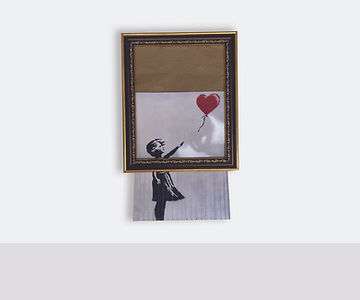
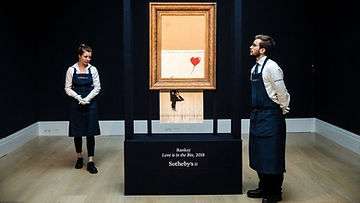
Banksy emerged as the digital age’s underdog of the art world, known as an anonymous British street artist, vandal, political activist and film director. With all of these titles under his belt, his artworks have been known to cause sensational discourse over various social themes, most of them combined with dark humour and graffiti. Which is why it comes as no surprise that he was the man behind the most shocking art prank of 2018. The painting ‘Girl with a Balloon’ started as a 2002 series of murals by Banksy depicting a young girl with her hand extended toward a red heart-shaped balloon being carried away by the wind. The artwork was the final item at an auction at Sotheby’s in London in October of 2018. As the hammer came down to confirm its sale, the canvas began to pass through a shredder attached to the frame, leading to the creation of a new original artwork. Banksy himself posted a video on his Instagram page showing the shredder being fitted into the frame of the painting explaining how he had secretly built a shredder into the painting in case it was ever out for action. The new work, born from the shredded ‘Girl with a Balloon’ was granted a certificate of authentication and given a new title ‘Love is in the Bin.’
Maurizio Cattelan, ‘Comedian’, 2019.
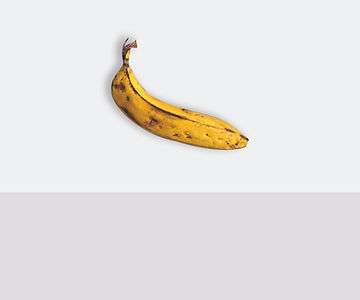
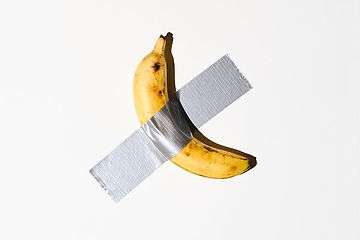
“My aim is to be as open and as incomprehensible as possible.” – Maurizio Cattelan
One of the world’s premier art fairs, Art Basel Miami Beach takes place every year, during the first week of December. Why was this year so memorable? Because Maurizio Cattelan represented by Galerie Perrotin, duct-taped a banana to the wall, titled it ‘Comedian’, and sold it for $120,000! Furthermore, after being bought by an art collector, the banana was eaten off the wall by performance artist, David Datuna. But Galerie Perrotin insisted that the artwork was not destroyed, as the idea lives on and therein lies any hope of understanding the ‘Comedian’. Maurizio Cattelan’s entire oeuvre is a reaction to socially accepted artworks and begs the question, “What is art?”. The art world’s resident jokester and arguably Duchamp’s greatest contemporary heir, Maurizio Cattelan famously declared, “my ideas are all the same but look different.”
As you have seen, we’ve come an entire circle of over a hundred years from 1917 to 2019 where this question “WHAT IS ART” is still being asked and is still relevant in today’s world. But the question is not one for us to answer but for you, the viewer to debate, discuss and finally decide.



